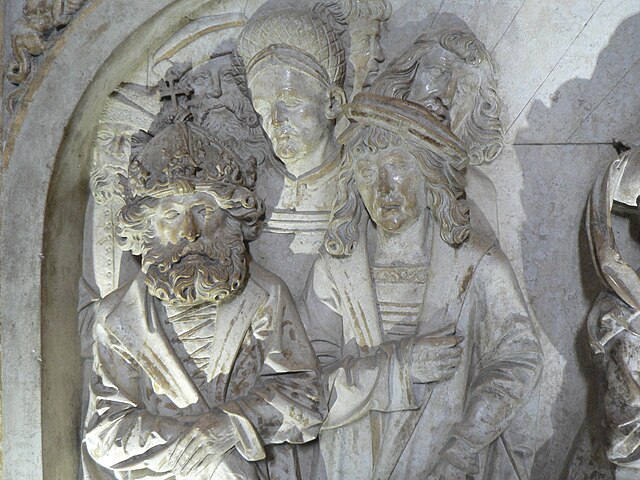Henry the Fowler was the Duke of Saxony from 912 and the King of East Francia from 919 until his death in 936. As the first non-Frankish king of East Francia, he established the Ottonian dynasty of kings and emperors, and he is generally considered to be the founder of the medieval German state, known until then as East Francia. An avid hunter, he obtained the epithet "the Fowler" because he was allegedly fixing his birding nets when messengers arrived to inform him that he was to be king.
Henry's seal from a document of 30 March 925. He is portrayed as a warrior, with a spear and shield. The words are HEINRICUS REX (King Henry).
Legend of the German crown offered to Henry while fixing his birding nets, by Hermann Vogel (1854–1921)
Finkenherd (finch trap) at Quedlinburg, built around 1530 at the legendary place of the king's bird trapping
Himmler at Henry's grave, 1938
The Ottonian dynasty was a Saxon dynasty of German monarchs (919–1024), named after three of its kings and Holy Roman Emperors named Otto, especially its first Emperor Otto I. It is also known as the Saxon dynasty after the family's origin in the German stem duchy of Saxony. The family itself is also sometimes known as the Liudolfings, after its earliest known member Count Liudolf and one of its most common given names. The Ottonian rulers were successors of the Germanic king Conrad I, who was the only Germanic king to rule in East Francia after the Carolingian dynasty and before this dynasty.
Depiction of the Ottonian family tree in a 13th-century manuscript of the Chronica Sancti Pantaleonis. The founder of the dynasty Liudolf, Duke of Saxony is at the top center.
Gandersheim Abbey Church
Former collegiate church of St. Servatius in Quedlinburg, founded in 936 by King Otto I, at the request of his mother Queen Matilda, in honor of her late husband, Otto's father, King Henry the Fowler, and as his memorial
Detail from the monument to Emperor Henry II, built over his tomb in Bamberg Cathedral more than 350 years after his death








